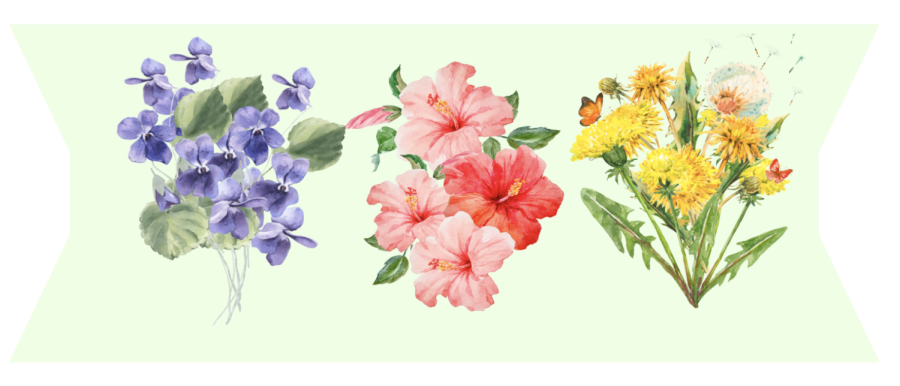Baking With a ‘Fleurish’
Edible Recipes Containing Real Flowers
As summer draws near, spring flowers are fading. The upcoming seasonal change allows for a last opportunity to enjoy fresh spring flowers in an unexpected way: using them to bake! From hibiscus to roses, many different flowers can be used to add taste and a fun new appearance to common baked goods. As real flowers tend to be an uncommon ingredient in sweets, the following recipes also provide an opportunity to become a better baker. Please note that the following recipes are safe for consumption only if the flowers used are grown organically (without or with extremely limited exposure to pesticides or other harmful chemicals).
- Wild Violet Sugar Muffins
These colorful treats are a fun twist on a regular muffin. Made first with wild violet sugar, the syrup is then baked into standard muffin batter, which means the muffin base can be replaced with any regular recipe. Below is the recipe for wild violet sugar (which may be baked into other recipes). A more detailed version of this recipe can be found here.
- Wash wild violets, then dry and pluck roughly 2 tbs worth of petals from violets.
- Combine petals in a food processor with ¼ cup sugar. Processing until finely ground.
- Place the sugar in slightly warm oven (heated for around 2 minutes) then let dry for at least 1 hour.
- Scrape dried sugar into the processor again. Process until any clumps are removed and the sugar is finely powdered.
- Store sugar in a bottle or jar in a cool, dark spot. It will keep for up to 9 months, though the purple color will gradually fade. Makes ⅓ cup violet decorating sugar.
- Honey and Dandelion Shortbread Cookies
Although they aren’t flowers in the traditional sense, dandelions can be used to add sweetness and bright color to most baked goods. The following recipe should be made with fully bloomed dandelions, meaning that fluffy seeds should not be visible. Be sure to cut off the stems of the dandelions before using them in the recipe. Do not use entire dandelion heads, rather pluck the petals from them before using. More detailed instructions can be found here.
Necessary ingredients:
- 1/2 cup dandelion petals
- 1/2 cup butter softened
- 1/2 cup powdered sugar
- 1 tablespoon honey
- 1 cup all purpose flour
- 1/4 teaspoon salt
Instructions:
- Preheat oven to 325 degrees.
- In a medium bowl, mix sugar and softened butter until light and fluffy.
- Mix in honey, then gently fold in dandelion petals.
- Add flour and sprinkle salt on top. Mix until just combined. For best results, leave dough to chill for roughly 30 minutes.
- Scoop dough by the tbs. Roll each tbs into a ball, then place on an ungreased cookie sheet. Use the bottom of a cup dipped in powdered sugar to flatten the cookies.
- Bake for 9-11 minutes, until slightly browned on the edges.
- Melon-Hibiscus Gelato
As the weather becomes warmer, consider enjoying this chilled treat with some friends. Although this recipe typically results in gelato with a light pink or light orange tint, other fruits can be added to enhance the flavor and taste. As with the previous recipes, be sure to remove the stems from the hibiscus flowers you use. A more detailed version of this recipe can be found here.
Necessary Ingredients:
- 4 cup cubed, seeded cantaloupe or 2 1/2 cups cubed, seeded watermelon
- 2 teaspoon finely shredded orange peel
- 1 cup sugar
- 6 egg yolks
- ¼ cup dried hibiscus flowers, coarsely broken (optional)
- 2 ¼ cup whole milk
- 1 cup unsweetened coconut milk or whole milk
- ¾ cup whipping cream
- ½ teaspoon salt
Instructions:
- In a blender, combine cantaloupe and orange peel. Blend until smooth. Strain through a sieve, then discard pulp and peel. Measure 1-1/2 cups of the melon liquid, then set aside.
- In a medium bowl combine sugar and egg yolks, then beat with an electric mixer on high for 4 minutes. Set aside this mixture.
- Place hibiscus flowers on a 6-inch square of double-thick cheesecloth, bring up sides, and tie closed with kitchen string.
- In a saucepan combine hibiscus, milk, coconut milk, cream, and salt, then heat just until simmering. Remove from heat and let stand for 2 minutes. Discard hibiscus.
- Stir 1 cup of the hot milk mixture into the egg yolk mixture. Return egg yolk mixture to the saucepan. Heat and stir for 5 minutes or until mixture thickens. Be careful not to let mixture boil. Place saucepan in a bowl of ice water; stir constantly for 2 to 3 minutes or until cool.
- In a large bowl combine melon mixture and egg yolk-milk mixture, stirring until well mixed. Cover surface of the mixture with plastic wrap. Chill about 4 hours.






